
The United States Capitol, often called the Capitol Building, is the home of the United States Congress and the seat of the legislative branch of the U.S. federal government. It is located on Capitol Hill at the eastern end of the National Mall in Washington, D.C. Though no longer at the geographic center of the Federal District, the Capitol forms the origin point for the District's street-numbering system and the District's four quadrants.

The Fifteenth United States Congress was a meeting of the legislative branch of the United States federal government, consisting of the United States Senate and the United States House of Representatives. It met in the Old Brick Capitol in Washington, D.C. from March 4, 1817, to March 4, 1819, during the first two years of James Monroe's presidency. The apportionment of seats in the House of Representatives was based on the Third Census of the United States in 1810. Both chambers had a Democratic-Republican majority.
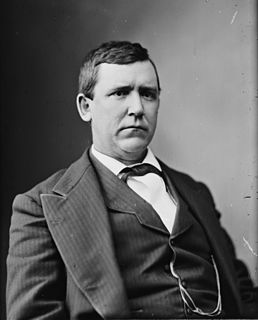
Augustus Hill Garland was an American lawyer and Democratic politician from Arkansas, who initially opposed Arkansas' secession from the United States, but later served in both houses of the Congress of the Confederate States and the United States Senate, as well as became the 11th Governor of Arkansas (1874-1877) and the 38th Attorney General of the United States (1885-1889).

Independence Hall is the building where both the United States Declaration of Independence and the United States Constitution were debated and adopted. It is now the centerpiece of the Independence National Historical Park in Philadelphia, Pennsylvania.
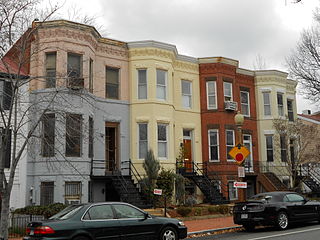
Capitol Hill, in addition to being a metonym for the United States Congress, is the largest historic residential neighborhood in Washington, D.C., stretching easterly in front of the United States Capitol along wide avenues. It is one of the oldest residential neighborhoods in Washington, D.C., and with roughly 35,000 people in just under 2 square miles (5 km2), it is also one of the most densely populated.

The Burning of Washington was a British invasion of Washington, D.C., the capital of the United States, during the War of 1812. On August 24, 1814, after defeating the Americans at the Battle of Bladensburg, a British force led by Major General Robert Ross burned down multiple buildings, including the White House, the Capitol building, as well as other facilities of the U.S. government. The attack was in part a retaliation for the recent American destruction of Port Dover in Upper Canada. The Burning of Washington marks the only time since the American Revolutionary War that a foreign power has captured and occupied the United States capital.
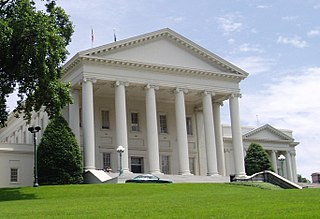
The Virginia State Capitol is the seat of state government of the Commonwealth of Virginia, located in Richmond, the third capital city of the U.S. state of Virginia. It houses the oldest elected legislative body in North America, the Virginia General Assembly, first established as the House of Burgesses in 1619.
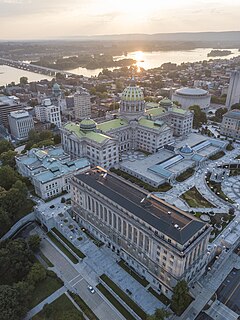
The Pennsylvania State Capitol is the seat of government for the U.S. state of Pennsylvania located in downtown Harrisburg which was designed by architect Joseph Miller Huston in 1902 and completed in 1906 in a Beaux-Arts style with decorative Renaissance themes throughout. The capitol houses the legislative chambers for the Pennsylvania General Assembly, made up of the House of Representatives and the Senate, and the Harrisburg chambers for the Supreme and Superior Courts of Pennsylvania, as well as the offices of the Governor and the Lieutenant Governor. It is also the main building of the Pennsylvania State Capitol Complex.
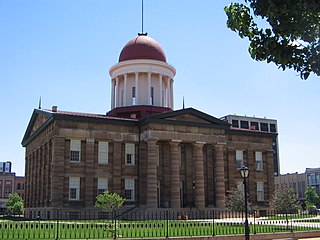
The Old State Capitol State Historic Site, in Springfield, Illinois, is the fifth capitol building built for the U.S. state of Illinois. It was built in the Greek Revival style in 1837–1840, and served as the state house from 1840 to 1876. It is the site of candidacy announcements by Abraham Lincoln in 1858 and Barack Obama in 2007. It was designated a National Historic Landmark in 1961, primarily for its association with Lincoln and his political rival Stephen Douglas.
Charles Cutts was an attorney and politician from New Hampshire. Among the offices in which he served were Speaker of the New Hampshire House of Representatives, United States Senator and Secretary of the United States Senate.

The United States Capitol rotunda is the central rotunda of the United States Capitol in Washington, D.C., built 1818–1824. It is located below the Capitol dome, built 1857–1866; the later construction also extended the height of the rotunda walls. It is the tallest part of the Capitol and has been described as its "symbolic and physical heart."
Samuel Nicholas Smallwood was the fifth and seventh mayor of Washington, D.C. and was the first popularly elected mayor of the city. Appointed to a one-year term in 1819, Smallwood was elected the following year to a two-year term, which he served from 1820–1822. He then was re-elected in 1824 but served only three months of his second term before dying at the age of 52.

The Belmont–Paul Women's Equality National Monument is a historic house and museum of the U.S. women's suffrage and equal rights movements located in the Capitol Hill neighborhood of Washington, D.C.. The monument is named after suffragists and National Woman's Party leaders Alva Belmont and Alice Paul.
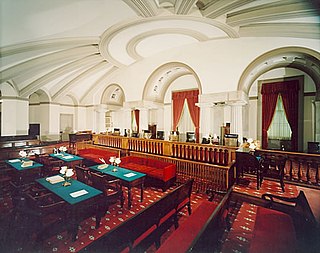
The Old Supreme Court Chamber is the room on the ground floor of the North Wing of the United States Capitol. From 1800 to 1806, the room was the lower half of the first United States Senate chamber, and from 1810 to 1860, the courtroom for the Supreme Court of the United States.

District of Columbia City Hall, also known as "Old City Hall" and the "District of Columbia Courthouse", is an historic building at Judiciary Square in downtown Washington, D.C. facing Indiana Avenue. Originally built for the offices of the District of Columbia district government, the District's City Hall was subsequently used as a Federal courthouse, and was the scene of several notable criminal trials including those of three accused presidential assassins. The building was declared a National Historic Landmark in 1960. It now houses the District of Columbia Court of Appeals.

James Moore Wayne was an American attorney, judge and politician who served as an Associate Justice of the Supreme Court of the United States from 1835 to 1867. He previously served as the 16th Mayor of Savannah, Georgia from 1817 to 1819 and the member of the United States House of Representatives for Georgia's at-large congressional district from 1829 to 1835, when he was appointed to the Supreme Court by President Andrew Jackson. He was a member of the Democratic Party.

The following outline is provided as an overview of and topical guide to Washington, D.C.:

The Public Buildings Act of 1926, also known as the Elliot–Fernald Act, was a statute which governed the construction of federal buildings throughout the United States, and authorized funding for this construction. Its primary sponsor in the House of Representatives was Representative Richard N. Elliott of Indiana, and its primary sponsor in the Senate was Bert M. Fernald of Maine (who served on the Senate Committee on Public Buildings and Grounds.
Much of Washington, D.C. was destroyed in the Burning of Washington on August 24, 1814 during the War of 1812. Following the destruction of Washington US leadership considered removing the Federal Government from D.C., but eventually choose to reconstruct the seat of government in D.C.

















